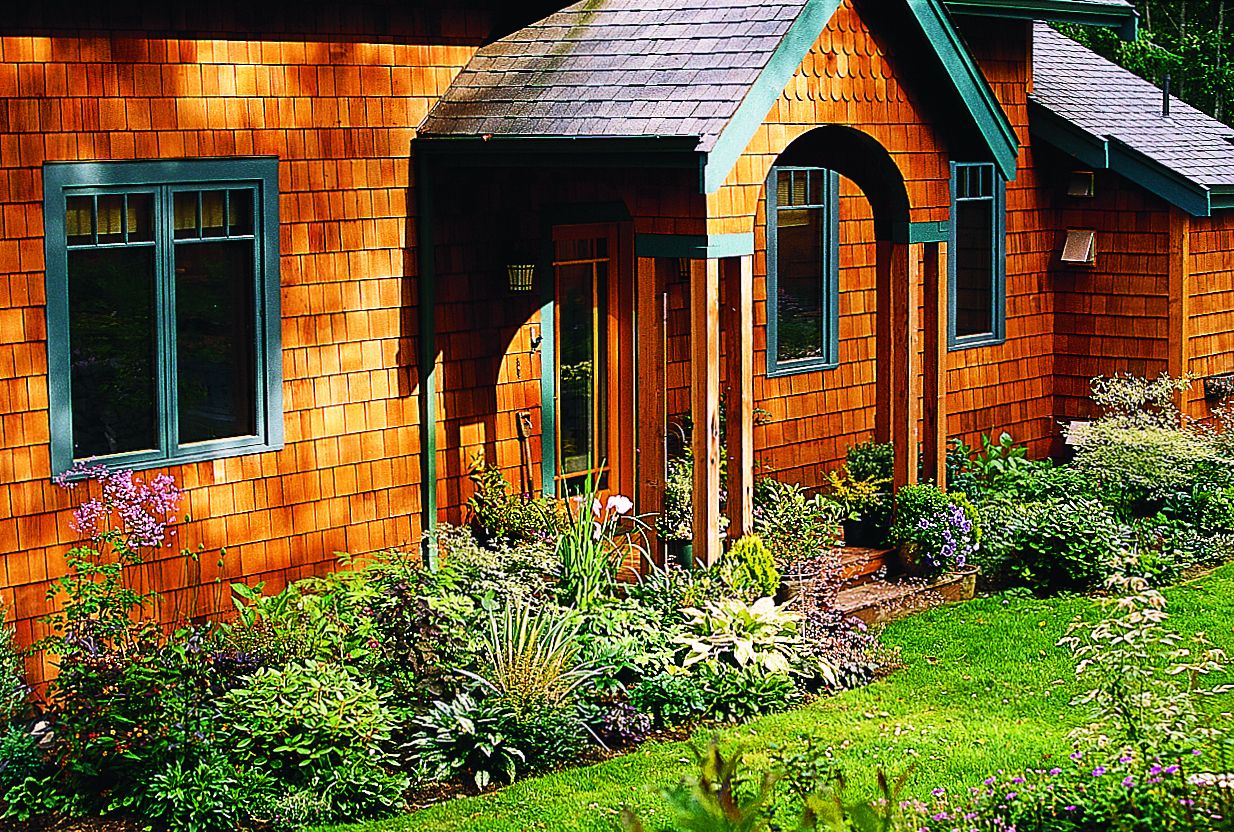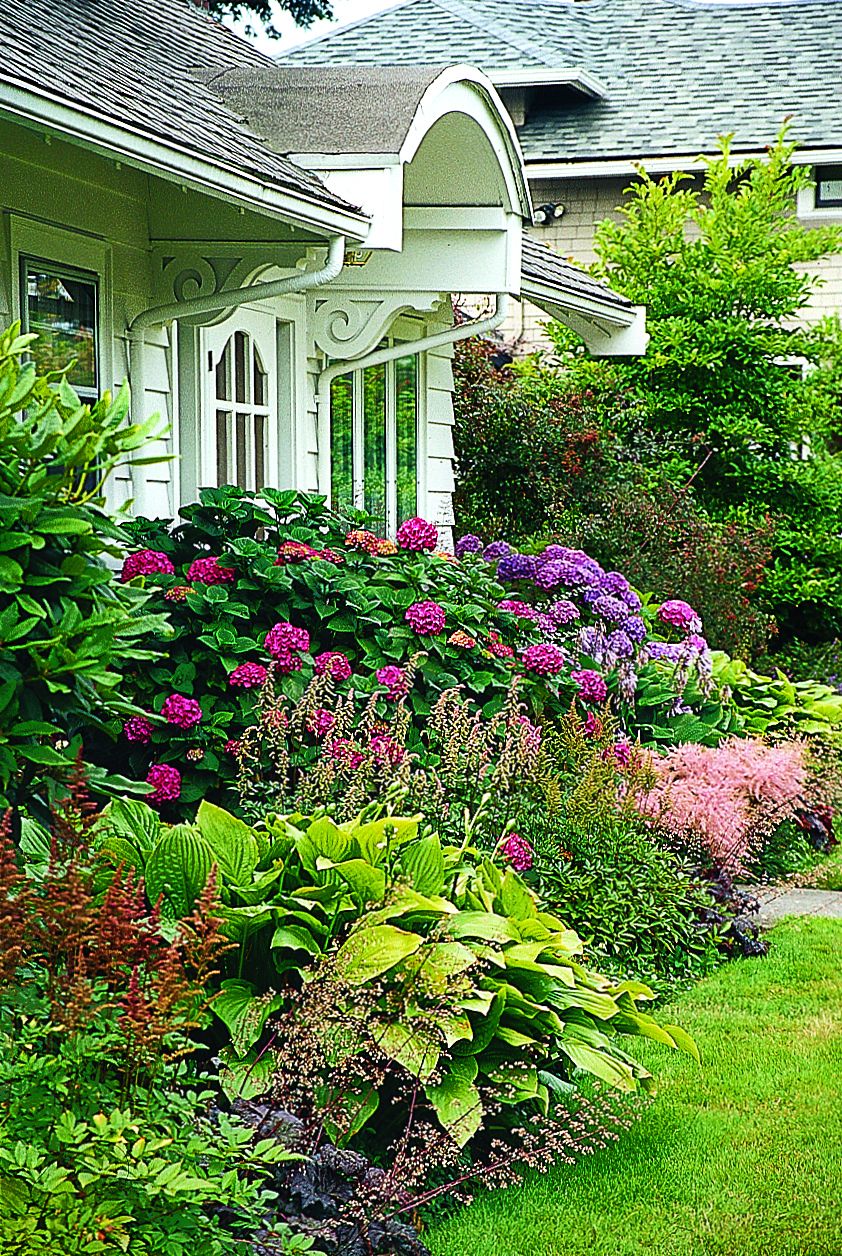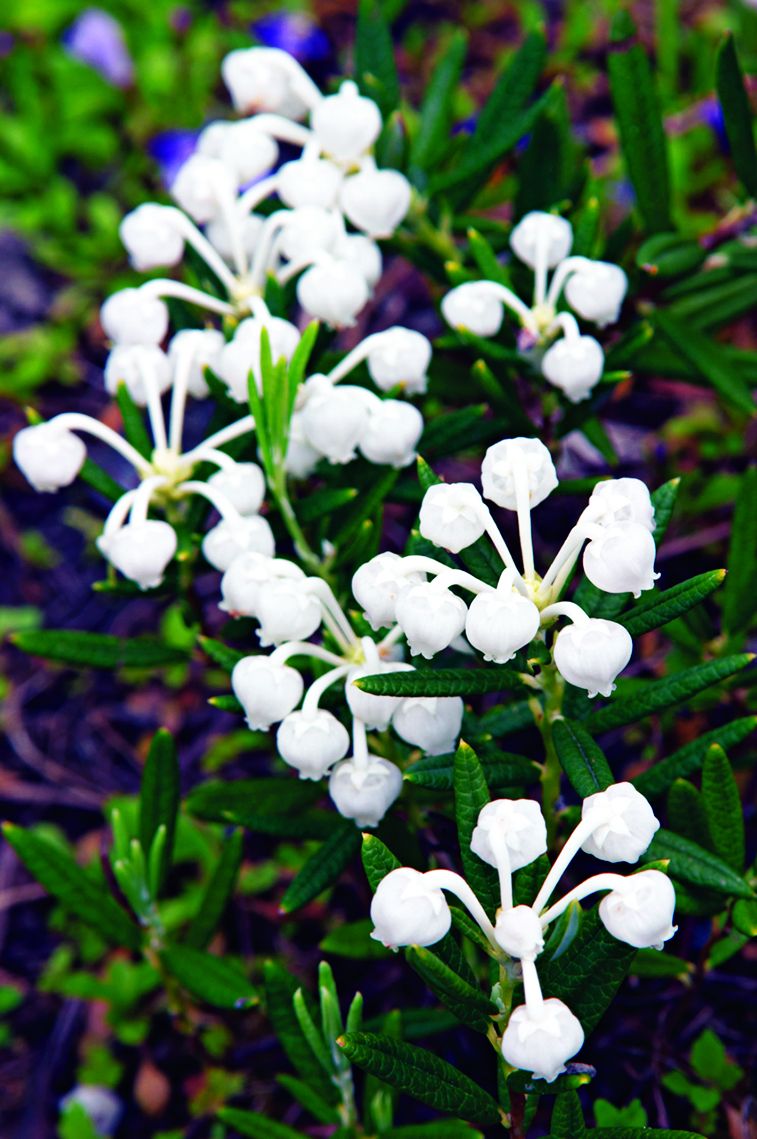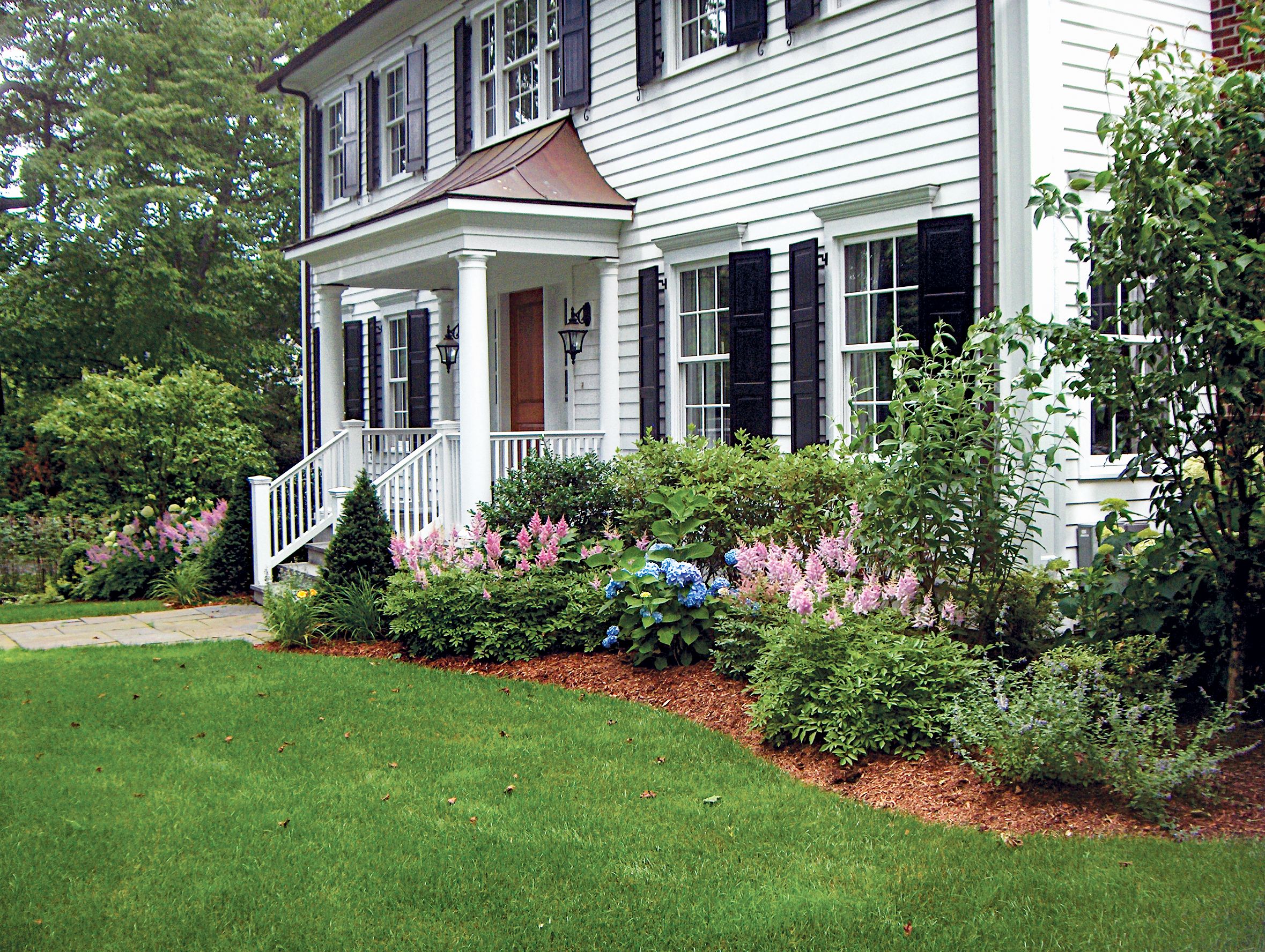Planting flowers and shrubs near your home’s foundation can dramatically boost your curb appeal. However, many homeowners struggle to create foundation plantings that truly complement their homes. Let’s explore some ideas and tips to help you landscape this area.
Foundation Planting Fundamentals
Here are our top three tips for choosing the right foundation plantings.
1. Work With the Architecture and House Style
The key to successful foundation planting is harmonizing with your home’s style. Different house designs call for different approaches. For formal homes, such as Georgians, Federals, or some Colonial Revivals, consider a more structured design. This could include symmetrical plantings on either entrance side, with neatly trimmed shrubs accentuating the doorway. Consider upright English oak, juniper, or groups of Leyland cypress to add a column-like effect.
If you have an informal cottage-style or ranch home, try a more relaxed, asymmetrical planting scheme. Medium-sized flowering trees like dogwood, Canadian redbud, crabapple, rose-of-Sharon, and crape myrtle all have a loose feel that suits a this more casual style.
Regardless of your design, avoid overcrowding or hiding the door. Instead, focus on creating a welcoming atmosphere with an interesting mix of plant colors and textures. Pay special attention to the area around the entrance, as this is where guests will get the closest look at your landscape.
For bare walls between windows, consider planting a larger shrub or small tree, or installing a trellis for climbing vines. Make sure you don’t block light or air circulation. Tall plans at the corners of the house can soften its edges and create the illusion of a larger property. Curved planting beds that gently lead the eye toward entryways can accentuate the design.
Homes without raised foundations or with handsome stonework may not need more than entrance and corner plantings. A bed of groundcover or mulch may be all you need to tie the two areas together—and make maintenance and mowing easier.

2. Go for Four Seasons of Interest
While evergreens provide year-round greenery, incorporating deciduous shrubs and perennials can make for a changing landscape throughout the seasons. Here are some tips:
- Choose plants with staggered bloom times.
- Include plants that produce attractive fruits or berries.
- Incorporate plants with attractive bark or branches that will look interesting in the winter.
- Select species that offer colorful fall foliage.
We recommend extending your planting beds out into the yard rather than limiting them to a narrow strip along the house. Layer plants from tallest to shortest, making sure new additions don’t overshadow established plants.
Also, consider adding hardscape elements such as garden boulders or decorative stones. This keeps things interesting during the dormant seasons when plants might not be at their peak.
3. Choose Correctly Sized Plants
One of the most common mistakes in foundation planting is failing to account for a plant’s mature size. Here are our tips to avoid this pitfall:
- Research the expected height and spread of each plant before purchasing.
- Choose dwarf varieties (two to four feet tall) for areas under windows and other tight spaces.
- Consider the plant’s growth rate and maintenance requirements.
- Allow for appropriate spacing between plants to promote healthy growth, prevent overcrowding, and minimize pruning needs.
Sketch a detailed plan before planting. We recommend enlarging a photo of your house and tracing it on paper. Add existing features, such as mature trees, then sketch in the plants you’re considering at their full-grown size and shape. This will help you visualize the final result.

Evergreen Shrubs
Evergreen shrubs can look more interesting than traditional, stiff, short-needled varieties. Here are some options:
- Andromeda (Pieris japonica): Features glossy green leaves and drooping white flower clusters. Grows up to 12 feet tall and thrives in partial shade. Hardy to 0 degrees Fahrenheit.
- ‘Blue Girl’ holly (Ilex meserveae): Offers blue-green foliage and red berries in fall. Reaches 7–10 feet tall and responds well to pruning. Full sun to partial shade; hardy to -10 degrees Fahrenheit.
- Inkberry (Ilex glabra): A deer-resistant shrub with glossy, dark green foliage and black berries in fall. Grows 6–10 feet tall, with compact varieties available. Sun to partial shade; hardy to -10 degrees Fahrenheit.
- Korean boxwood (Buxus microphylla ‘Koreana’): Fast-growing and ideal for creating formal accents or edging. Reaches about two feet tall. Full sun to partial shade; hardy to -0 degrees Fahrenheit.
- Mountain laurel (Kalmia latifolia): Features leathery, dark green leaves and clusters of pink, white, or red flowers in late spring. Slow-growing, reaching up to 10 feet tall. Partial shade, moist soil; hardy to -10 degrees Fahrenheit.
Remember, evergreen shrubs have many colors and textures. For instance, incorporating needle-leaved evergreens such as dwarf spruce or pine can contrast against broader-leaved varieties.

Summer-Flowering Shrubs for Foundation Planting
These summer-flowering shrubs can help keep your yard colorful past the typical spring blooming season:
- ‘Betty Prior’ rose (Rosa ‘Betty Prior’) and ‘Knock Out’ rose (Rosa ‘Knock Out’): Compact, disease-resistant roses that bloom all summer. Can be maintained at three to four feet tall. Prefer sun but do well in partial shade; hardy to -20 degrees Fahrenheit.
- ‘Endless Summer’ hydrangea (Hydrangea macrophylla ‘Bailmer’): Produces repeat blooms on both new and old wood. Reaches up to five feet tall. Prefers morning sun and afternoon shade; hardy to -20 degrees Fahrenheit.
- Summersweet (Clethra alnifolia): Has fragrant white flower spikes in mid to late summer. Sixteen Candles variety grows 3-4 feet tall and attracts butterflies and hummingbirds. Ruby Spice reaches up to 8 feet with pink flowers. Both have foliage that turns yellow/orange in fall. Sun to partial shade, moist soil; hardy to -30 degrees Fahrenheit.
Consider integrating flowering shrubs that look beautiful across multiple seasons. Varieties such as the butterfly bush (Buddleia) attract pollinators and come in many colors. Shrubs that produce fruit also add beauty and attract various garden wildlife.

Perennials and Ornamental Grasses for Foundation Planting
Incorporate these perennials and ornamental grasses to add texture, movement, and long-lasting color to your foundation planting:
- ‘Autumn Joy’ sedum (Sedum ‘Autumn Joy’): Offers year-round interest with large clusters of rose-colored flowers in late summer to early fall. Full sun; hardy to -30 degrees Fahrenheit.
- Catmint (Nepeta spp.): Features gray-green foliage and lavender-blue flowers from summer to fall. ‘Six Hills Giant’ grows three to four feet tall, while ‘Walker’s Low’ reaches 18 inches. Full sun; hardy to -20 degrees Fahrenheit.
- Chinese fountain grass (Pennisetum alopecuroides): Grows 3 feet tall with soft pink flower clusters and showy seed heads in fall. Full sun; hardy to 0 degrees Fahrenheit.
- Coneflower (Echinacea spp.): Hardy perennial with long-lasting pink, purple, or white flowers on stiff stems in mid to late summer. Full sun; hardy to -20 degrees Fahrenheit.
- ‘Karl Foerster’ grass (Calamagrostis x acutiflora ‘Karl Foerster’): Upright ornamental grass with glossy dark green foliage and pinkish-bronze flower heads. Full sun; hardy to -10 degrees Fahrenheit.
- ‘Stella de Oro’ daylily (Hemerocallis ‘Stella de Oro’): One of the longest-blooming daylilies, producing bright yellow flowers throughout summer. Full sun to partial shade; hardy to -30 degrees Fahrenheit.
- ‘Zagreb’ coreopsis (Coreopsis verticillata ‘Zagreb‘): Compact variety with bright yellow daisy-like flowers all summer, suitable for both formal and casual plantings. Drought tolerant; grows 12 inches tall. Full sun; hardy to -20 degrees Fahrenheit.
You can also include plants such as yucca for architectural flair or Japanese forest grass for a cascading effect. By mixing textures, colors, and bloom times, you can create captivating displays that evolve throughout the seasons.
Foundation Planting Maintenance Considerations
Follow our tips to keep your foundation planting looking its best:
- Fertilize as needed, following specific requirements for each plant species.
- Implement a regular pruning schedule to maintain desired shapes and sizes.
- Install an irrigation system or set up a watering schedule for consistent moisture.
- Monitor for pests and diseases. Address issues promptly.
- Mulch annually to retain moisture and suppress weeds.
Consider seasonal tasks such as deadheading spent flowers to encourage further blooming and cleaning up leaves in fall. Proactive maintenance not only promotes healthier plants but also keeps the landscape looking fresh and well-tended throughout the year.

